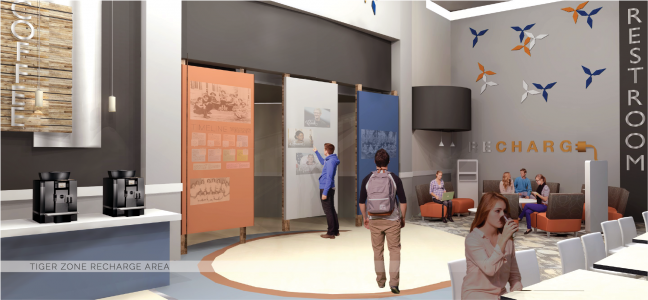Post contributed by Kaitlin Robb, Office of Sustainability Intern
You may have noticed Village Dining looking a little different over the last year. A few changes are obvious, such as the tree mural painted by the entrance and the large tiger panels framing Tiger Zone. Some changes you may not have noticed yet, like the new carpeting and the multi-use rooms. What you probably don’t know, however, is that the new design was created by students.
Anna Ruth Gatlin, an Interior Designer for Auburn University and an adjunct professor, incorporates sustainability into her Interior Materials and Components class. When teaching about materials, she discusses the sustainability-related pros and cons of each product. Her class is designed to be thought-provoking. Therefore, last semester she gave her students a special final project. She split them into six teams, each tasked to redesign Village Dining. They had a client, Glenn Loughridge, Director of Tiger Dining, and their project was unique, as one design would actually be implemented for Tiger Dining.

The winning team envisioned multi-use spaces to help enhance the dining experience.
The winning design consisted of three core elements: student satisfaction, Auburn history, and sustainability. Rachael Snow, a member of the winning team, was coincidentally chosen to be an intern with the Facilities Management Design Services unit. As a result, she has been working to execute her own team’s design. Design students conceptualize countless projects, but rarely see them carried out during their academic years. By designing a project for an actual client and then implementing the design, she has been able to see what does and doesn’t work beyond the conceptualization stage.
As part of their design, the winning team envisioned Village Dining as a multi-use space. As a result, Tiger Zone now has study spaces for students, along with repurposed rooms, which host events like Healthy Tigers Lunch and Learns for employees. The Tiger Zone area also has new recharge stations for students, and a “green wall” covered in plants, intended to “bring the outside in,” which supports cognitive behavior and makes people feel at peace. In addition, a future plan is to use televisions in the buffet area to educate consumers about food waste and encourage them to take only the food they intend to eat.
When thinking of what products to use, Rachael and her team considered durability. A new demountable wall unit, developed by the company DIRTT, will be covered in removable vinyl sheets. These sheets will show Auburn University and Greek-life history, but can also be changed to show seasonal topics, such as Black History Month. Although vinyl isn’t the most sustainable, the material allows the sheets to be reused, which in the long run is more sustainable than replacing the walls every time something new would be showcased.
One sustainable material used in the redesign is Interface carpets. Interface’s goal is to be zero waste. They’ll take any carpets, recycle them, and then produce new carpets made of recycled materials. Some of their carpets are made from discarded fishing nets recovered from impoverished, coastal communities. The company produces every material with the end of the product’s life in mind. They use recycled materials to reduce landfill impacts and to work towards their goal of ending their dependence on oil. Carpeting in Village Dining has now been replaced with carpets from this socially and environmentally responsible company.
Although the more obvious sustainability initiatives, like replacing the lights from halogen to LED, have been implemented into the redesign of Village Dining, the design of the winning team and the efforts of Rachael and Anna Ruth showcase what is beyond the obvious. The different elements in a sustainable design go beyond just materials, as a designer must consider durability, functionality, and atmosphere. Redesigning underutilized spaces keeps resources from being wasted; “green walls” are good for wellbeing; and experiential learning gives students an education beyond the classroom. So next time you’re in Village Dining, take a moment to appreciate the new design- it goes beyond what you can see.




